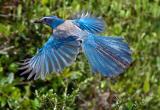Climate Change and Florida Scrub Jays by Defenders of Wildlife
Merritt Island National Wildlife Refuge provides some of the most important remaining habitat for the Florida scrub-jay, the only bird whose entire range is restricted to Florida. The scrub-jay is officially listed as a threatened species as a result of its dramatic population declines in the face of the ongoing conversion, loss, and modification (including fire suppression) of its native oak-scrub habitat.
Established in 1963 as an overlay of NASA’s famed John F. Kennedy Space Center on Cape Canaveral, Merritt Island NWR includes intact remnants of the oak scrub once found throughout the well-drained sandy soils in the Florida peninsula. In 2007, as the U.S. Fish and Wildlife Service developed its Comprehensive Conservation Plan and Environmental Assessment for Merritt Island, Defenders of Wildlife analyzed the available scientific research on the Florida scrub-jay and identified several areas of concern related to climate change.
- Because hurricanes increase the extinction risk of coastal Florida scrub jay populations (Breininger et al. 1999), the increased storm intensity and frequency associated with global warming could further endanger Florida scrub jays.
- In wild areas without supplemented human food sources, scrub jays eat many energy-rich acorns (Fleischer et al. 2003). Researchers hypothesize that individuals that forage and handle more food breed earlier, suggesting that foraging efficiency might be a perceptual cue for breeding. Scrub jay breeding schedules rely heavily on nutritious food, so further research is necessary to determine negative effects of climate change on their food sources (mainly acorns, lizards, and frogs).
- Florida scrub jays are susceptible to inadequate fire management and fire suppression (Breininger et al. 1999, Breininger et al. 2006). Further research is necessary regarding the best scrub fire management as global warming increases drought and fluctuating fire regimes as expected.
- Current projections suggest that present habitat will not support Florida scrub jay populations for the next 60 years (Root 1998), especially since the populations are currently small and unlikely to survive a major epidemic or catastrophe. The best ways to overcome future population declines are to increase connectivity between populations and acquire and/or restore additional scrub habitat to optimal conditions (Breininger et al. 1999, Root 1998).
- Further research should determine how global warming could affect scrub habitat, since it characteristically occurs on well-drained sites with low nutrient levels and periodic fires -- all factors that could be affected by climate change (Mumme et al).
Research Cited
Breininger, D., Burgman, M., Stith, B. 1999. Influence of habitat quality, catastrophes, and population size on extinction risk of the Florida scrub jay. Wildlife Society Bulletin, 27, 3: 810-822.
Breininger, D., Toland, B., Oddy, D., Legare. 2006. Landcover characterizations and Florida scrub jay population dynamics. Biological Conservation, 128: 169-181.
Fleischer, A., Bowman, R., Woolfenden, G. 2003. Variation in foraging behavior, diet, and time of breeding of Florida scrub jays in suburban and wildland habitats. The Condor, 105: 515-527.
Mumme, R., Schoech, S., Woolfenden, G., Fitzpatrick, J. 2000. Life and death in the fast lane: Demographic consequences of road mortality in the Florida scrub jay. Conservation Biology, 14, 2: 201-512.
Root, K. 1998. Evaluating the effects of habitat quality, connectivity, and catastrophes on a threatened species. Ecological Applications, 8,3: 854-865.






